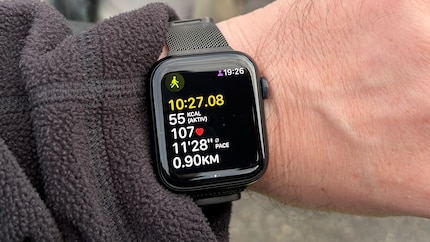

Project Half Marathon: if you run with a pushchair, you may as well not bother
The first two weeks of my attempt at the half marathon were characterised by misjudgements, misunderstandings and, fortunately, a surge of motivation. Thank goodness for chest straps.
This is me now: slightly exhausted, sporting a headache, but happy and satisfied. It’s 8.30 p.m. on Easter Monday, and I’ve just completed my first run, although run is a bit of an exaggeration. I’m on a long journey to the half marathon in September, so I’m currently doing basic training. In other words, I’ve been advised not to push my pulse above 115 beats per minute. So, I’ve decided to make my evening walks a bit more intensive in order to achieve the required heart rate. If you’re wondering what this low heart rate range is, you’re already one step ahead of me. But more on that later.

Source: Claudio Candinas
One man and his pushchair
As my colleague Oliver Fischer and I mentioned at the start of our series, our free time is rather limited due to work, family and other excuses, so we have to get creative when it comes to our training times and routines. In my case, this means I now take my son with me to evening training sessions, as he doesn’t like to be put to bed by anyone but me. And so I march quickly in my bright yellow running shoes along local country lanes, pushing our Thule pram ahead of me.

I think I look like one of those over-zealous fitness dads, just carrying an extra 10 kg. Whatever, I can’t overthink it now. I try to concentrate as much as possible on achieving the optimum heart rate and, above all, on enjoying the gorgeous view. I can’t say whether or not my son likes the training session, but it’s certainly not boring enough to send him to sleep. Unfortunately, my plan is foiled.
Reading helps
After a good hour, I’m back home and spend the next 60 minutes trying to get my shaken-awake son to go to sleep. My interim verdict is that going running with my son doesn’t really make sense. What’s more, when I look at my results, I realise I’ve memorised the wrong heart rate parameters – I’ve got mixed up with those for cycling. When jogging or walking, I should ideally reach 125 beats per minute instead of 115. Great, I think to myself. So the first training session was a figurative pain in the backside. Ironically, my posterior wasn’t even sore or aching. Oh well. Onwards and upwards.
Three days later, I decide to go for a lunchtime run. It was meant to be a 5 K. Equipped with my fitness watch and smartphone, I set off. It definitely feels much more liberating to jog without a pushchair. And the playlist I put together to motivate myself does the job. If you’re an experienced runner shaking your head right now: yes, I soon realised it makes no sense to run holding a smartphone. The status updates about my run on the display distract me far too much, and it’s almost impossible to keep a fairly constant pace. But stopping is definitely not an option. I complete the five kilometres, and it takes me well over an hour. You don’t have to be a maths whizz to crunch the numbers. It’s damn slow.
Beloved gadgets
Once home, it’s off to the shower then straight to the sports clothes drawer. My old heart rate belt is hiding in here somewhere. I’ve always been a gadget freak, and if you measured my fitness based on the sports equipment lying around my house, I’d be a gold medal winner. There it is, the Polar H10. I quickly insert a new battery, put on the chest strap and try to connect it to my Apple Watch. Fortunately, YouTube comes to the rescue. I quickly find a tutorial, and in no time at all I’m reading the data from the chest strap on the display on my wrist. Perfect. So now there’s nothing standing in the way of my next run, not even a smartphone in my hand.
As a result, my third and fourth runs are much more pleasant and effective. I run eight kilometres in under an hour – which is still a long way off being a good running performance, but it’s a big step forward for me. And lo and behold, running becomes a lot more fun. The next few weeks will show whether this is just initial euphoria, which, as is so often the case in life, dies down relatively quickly, or whether I’ll be motivated to see the whole thing through. I’m optimistic, and will be taking away the following four lessons from my first two weeks since the performance analysis:
- Evening runs with a pushchair don’t make my daily routine any more efficient.
- If you can read analysis tables correctly, you’re at an advantage and can train in the right heart rate range from the start.
- Running with your smartphone in your hand is both awkward and distracting. It also has a negative impact on your training results.
- I need (sun)glasses for running. My eyes start watering while I’m running – perhaps out of sheer joy.
I’m excited to seewhat happens in the next few weeks, and most of all, to find out how Oliver’s doing as he battles through daily training. My next goal isn’t linked to a specific distance. Instead, I’m focussing on being able to run for a certain time. But more on that in the next article – hopefully.
I'm a fan of ideas that make you shake your head at first. And of coffee.
Interesting facts about products, behind-the-scenes looks at manufacturers and deep-dives on interesting people.
Show all



